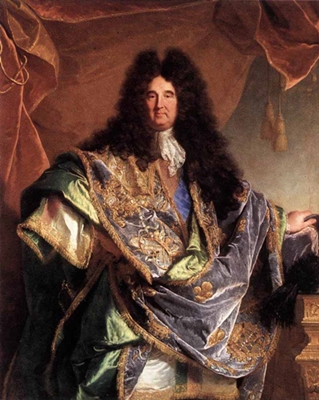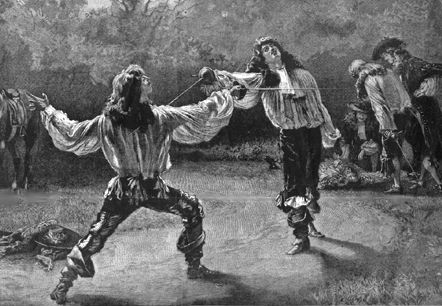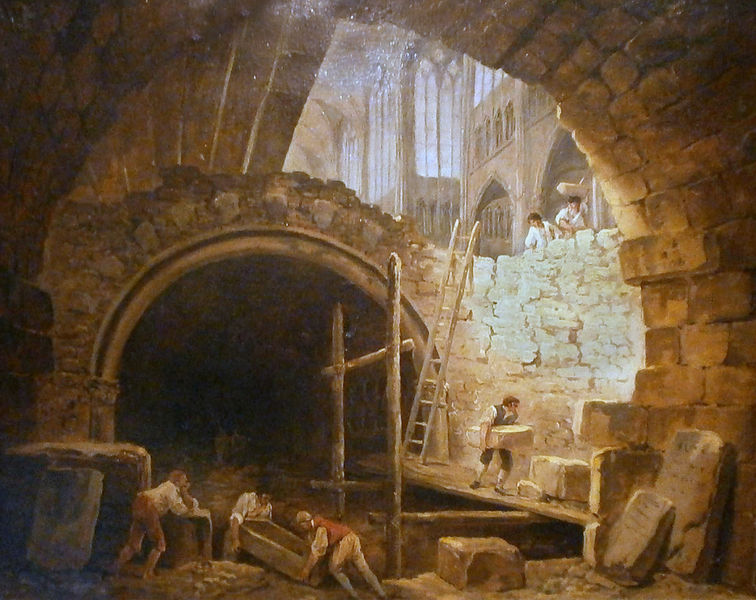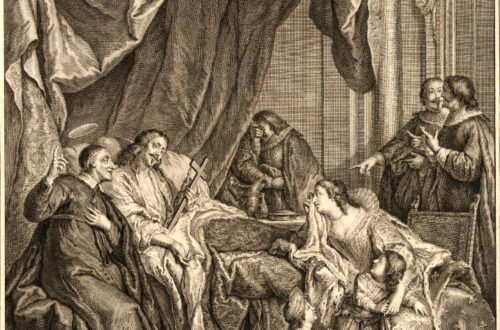L’affaire de la garde corse
In August 1662, a little over a year after the death of Cardinal de Mazarin and Louis XIV taking things into his own hands, there was a bit of an incident between France and the Vatican which temporarily halted all diplomatic relations… and even after that, things would never be the same.
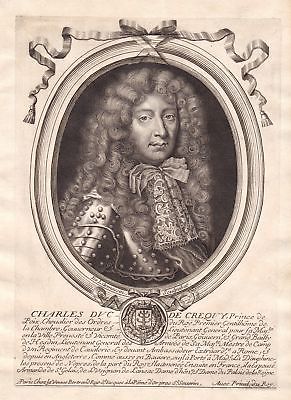 Charles de Blanchefort-Créquy served Louis XIV splendidly on various diplomatic issues, thus Louis decided to promote him from Comte to Duc and made him his ambassador to Rome. Quite the honour. The new Duc set out for Rome with his wife and various members of their household. They settled at the beautiful Palazzo Farnese, the residence of the French ambassadors to the Holy See.
Charles de Blanchefort-Créquy served Louis XIV splendidly on various diplomatic issues, thus Louis decided to promote him from Comte to Duc and made him his ambassador to Rome. Quite the honour. The new Duc set out for Rome with his wife and various members of their household. They settled at the beautiful Palazzo Farnese, the residence of the French ambassadors to the Holy See.
Due to various privileges the various diplomats held, their persons, families, entourage, everyone affiliated with the residence and the residence itself were out of reach for the Papal and Roman authorities. They did not have any powers over the embassy. Of course, the borders of what belonged to the embassy were stretched over the centuries. In first it was just the building, then it came to include the streets bordering it, then it came to also include pretty much everything around it, as in even the buildings across the road. This was called liberty of quarters and since those areas were untouchable, it led to a rise of crime and made them a refuge for criminals.
Pope Alexander VII made an attempt to limit all of that. Spain and the Holy Roman Empire took actions to do so as well. France did not. The Duc de Créquy not just had his wife and staff in tow, but also a quite large military escort. And he did not play along when it came to limiting the so-called quarters either. The Duc requested the French one to be extended to include the street which the Corsican Guard took every day from their barracks at the Trinità dei Pellegrini to reach the Carceri Nuove, the State prison. This Corsican Guard was composed exclusively of Corsican mercenaries, which belonged to the military unit of the Papal State and was a bit of an urban militia and Papal guard. Rome did not like that request at all and thus increased the number of Corsican Guards patrolling the streets.
On August 20, a nice Sunday, at around 7 o’clock in the evening, at the Ponte Sisto, a bit of a quarrel broke out between some of the French guards and the Corsican Guard. After the French threw some insults at the Corsicans, a fight broke out. Nobody was wounded and the fight did not last long. The French proceeded over the bridge, where they spotted another member of the Corsican Guard, a man named Giovanni da Calenzana. Again, after insults were exchanged, a fight broke out, but this time someone, Giovanni da Calenzana, was wounded. Two Corsican soldiers, who happened to pass by, rushed to help him and broke the fight up. The French quickly returned to the refuge of the Palazzo Farnese.
Word of it reached the Corsican barracks. Rumours started to spread that armed French Guards killed two Corsicans, Giovanni de Calenzana and Giovan Battista d’Ajaccio, and were now marching from the Palazzo Farnese in direction of the barracks to set them aflame. Meanwhile, the French gathered by the embassy, to defend it from approaching Corsicans and while Giovanni de Calenzana was indeed wounded, he still was very much alive.
The officers of the Corsican Guard tried their best to keep their men calm in the barracks, but to no avail. Some of them sneaked out to join the fight at the Palazzo to demand that those responsible for what happened at the bridge would be handed over to them at once. The Duc de Créquy had no clue what was going on at the besieged Palazzo Farnese as he arrived there in his carriage from a visit to the Princesses Borghese. Detonations echoed through the neighbourhood. The Duc inquired about what was going on and managed to restore peace between the French and Corsican guards… but then, without warning, muskets were fired by the Corsicans that had just arrived on the scene, probably not knowing peace had been restored just then. Bullets hit the building, the carriage of the Duc, the Duc was wounded and one unlucky passerby killed. Of course, the French fired back at once.
As the Corsicans spotted two more carriages approaching, they planned to ambush them. Madame de Créquy was in one of them. The fight that ensued over the carriages, killed a page of the Duc and seriously wounded Antoine de Boys, the captain of the Duc’s guards. The terrified Madame de Créquy was nearly hit by a bullet as well and ran for her life to the estate of Cardinal d’Este.
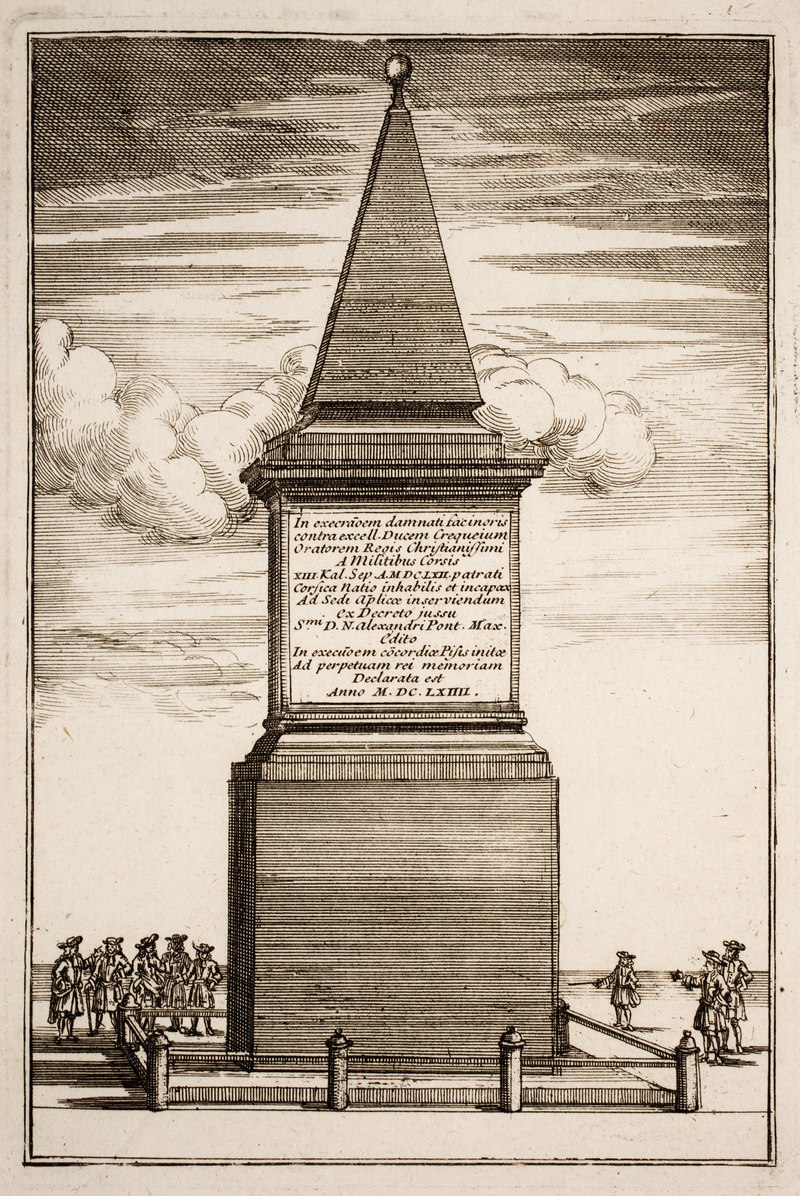
By the end of the day, several guards were death or seriously wounded and in the following days, some of those seriously wounded passed away as well. Including the captain of the Duc’s guards.
Word of what happened that day in Rome, reached Louis XIV on August 29 , while he was enjoying the warm summer at Saint-Germain. He was not amused and all diplomatic ties with Rome were put on halt. The Sun King demanded a public apology, the immediate dissolution of the Corsican Guard and the issuing of an anathema against Corsica, in retaliation of a number of soldiers should be hanged and others should be condemned to serve on the galleys. Louis also demanded the removal of Cardinal Imperiali as Governor of Rome and the exile of Mario Chigi, brother of the Pope, who was the commander of the Corsian Guards. The French accused both of them of provoking the whole thing. To crown the demands, a pyramid should be erected in front of the Corsican barracks to mark the site and curse those involved.
The Pope and Cardina Lorenzo Imperiali, acknowledged the gravity of the incident at once. They also dismissed the Corsicans immediately and were willed to pay indemnity to France… but that was not enough for Louis XIV. Thus the Duc de Créquy was called home and left Rome along with the Cardinals who sided with France. The Nuncio was dismissed from Paris. Louis XIV prepared for an armed conflict and it was decided the Papal possessions in Avignon should be annexed.
In first the Pope opposed the terms Louis XIV demanded, but the thought of a large French army marching on Rome persuaded him to agree to them. Two years later, on February 12 in 1664, the Treaty of Pisa was signed and the Sun King got what he wanted. The Corsican Guard was forever disbanded, some of them were hanged, Mario Chigi was exiled from Rome, the Corsican nation forbidden from ever serving the Papal States again. In exchange, the annexed Papal possessions in Avignon were returned.
Louis XIV also got his public apology. Flavio Chigi, nephew to the Pope and son of the exiled Mario Chigi, had to travel all the way to Fontainebleau and humble himself in front of the Sun King and his court. A pyramid, as the monument of infamy, was erected as well.
